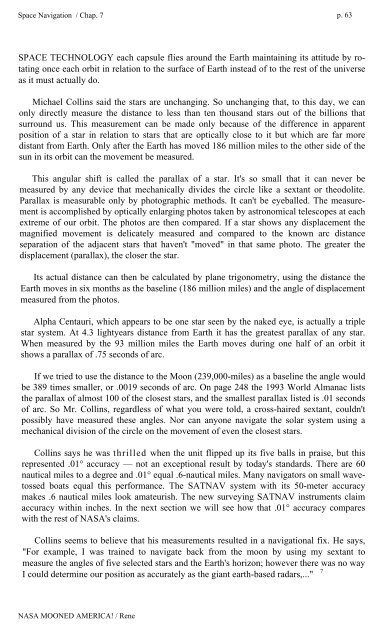Rene-NASA-Mooned-America
Rene-NASA-Mooned-America
Rene-NASA-Mooned-America
Create successful ePaper yourself
Turn your PDF publications into a flip-book with our unique Google optimized e-Paper software.
Space Navigation / Chap. 7 p. 63<br />
SPACE TECHNOLOGY each capsule flies around the Earth maintaining its attitude by rotating<br />
once each orbit in relation to the surface of Earth instead of to the rest of the universe<br />
as it must actually do.<br />
Michael Collins said the stars are unchanging. So unchanging that, to this day, we can<br />
only directly measure the distance to less than ten thousand stars out of the billions that<br />
surround us. This measurement can be made only because of the difference in apparent<br />
position of a star in relation to stars that are optically close to it but which are far more<br />
distant from Earth. Only after the Earth has moved 186 million miles to the other side of the<br />
sun in its orbit can the movement be measured.<br />
This angular shift is called the parallax of a star. It's so small that it can never be<br />
measured by any device that mechanically divides the circle like a sextant or theodolite.<br />
Parallax is measurable only by photographic methods. It can't be eyeballed. The measurement<br />
is accomplished by optically enlarging photos taken by astronomical telescopes at each<br />
extreme of our orbit. The photos are then compared. If a star shows any displacement the<br />
magnified movement is delicately measured and compared to the known arc distance<br />
separation of the adjacent stars that haven't "moved" in that same photo. The greater the<br />
displacement (parallax), the closer the star.<br />
Its actual distance can then be calculated by plane trigonometry, using the distance the<br />
Earth moves in six months as the baseline (186 million miles) and the angle of displacement<br />
measured from the photos.<br />
Alpha Centauri, which appears to be one star seen by the naked eye, is actually a triple<br />
star system. At 4.3 lightyears distance from Earth it has the greatest parallax of any star.<br />
When measured by the 93 million miles the Earth moves during one half of an orbit it<br />
shows a parallax of .75 seconds of arc.<br />
If we tried to use the distance to the Moon (239,000-miles) as a baseline the angle would<br />
be 389 times smaller, or .0019 seconds of arc. On page 248 the 1993 World Almanac lists<br />
the parallax of almost 100 of the closest stars, and the smallest parallax listed is .01 seconds<br />
of arc. So Mr. Collins, regardless of what you were told, a cross-haired sextant, couldn't<br />
possibly have measured these angles. Nor can anyone navigate the solar system using a<br />
mechanical division of the circle on the movement of even the closest stars.<br />
Collins says he was thrilled when the unit flipped up its five balls in praise, but this<br />
represented .01° accuracy — not an exceptional result by today's standards. There are 60<br />
nautical miles to a degree and .01° equal .6-nautical miles. Many navigators on small wavetossed<br />
boats equal this performance. The SATNAV system with its 50-meter accuracy<br />
makes .6 nautical miles look amateurish. The new surveying SATNAV instruments claim<br />
accuracy within inches. In the next section we will see how that .01° accuracy compares<br />
with the rest of <strong>NASA</strong>'s claims.<br />
Collins seems to believe that his measurements resulted in a navigational fix. He says,<br />
"For example, I was trained to navigate back from the moon by using my sextant to<br />
measure the angles of five selected stars and the Earth's horizon; however there was no way<br />
I could determine our position as accurately as the giant earth-based radars,..." 7<br />
<strong>NASA</strong> MOONED AMERICA! / <strong>Rene</strong>


